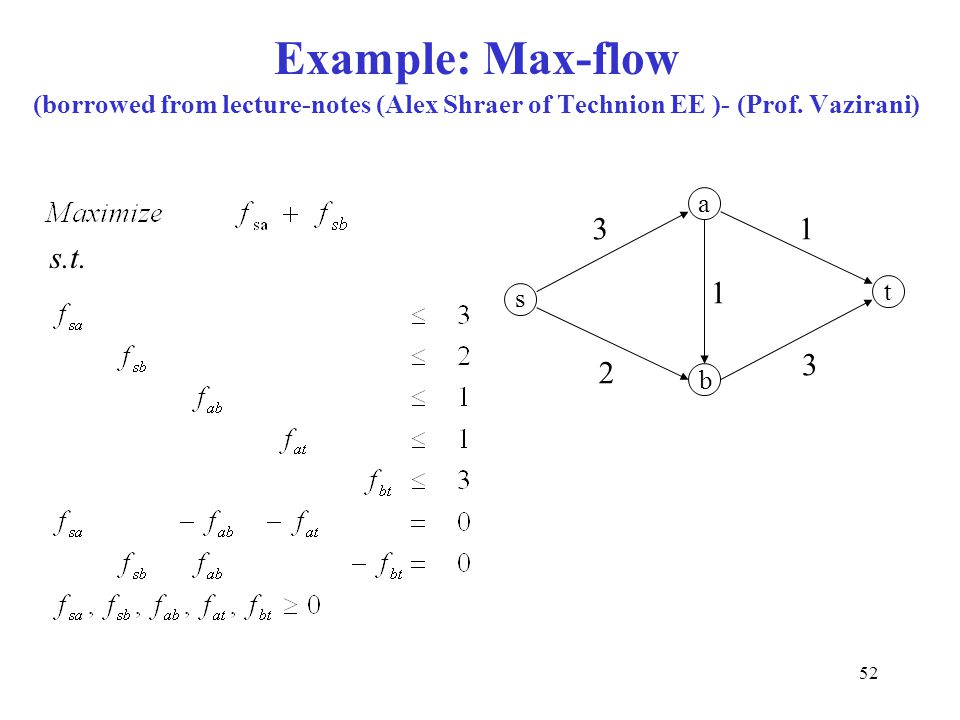求解软件有,
matlab,lingo,商用软件
GLPK,GNU LP Kit,开源,ansi C
介绍图的匹配,matching
https://www.tutorialspoint.com/graph_theory/graph_theory_matchings.htm
最大流问题,有许多图的基础知识
https://blog.csdn.net/qq_39557517/article/details/81945749
介绍如何使用GLPK
https://www-sop.inria.fr/members/Frederic.Giroire/teaching/ubinet/pdfs/exercises-solvers.pdf
线性规划基本介绍:https://www.cs.cmu.edu/~ckingsf/bioinfo-lectures/linearp.pdf
线性规划三种求解方法:
Simplex method,单纯形法,古老的方法,虽然不是多项式时间算法,但实际计算很快;
Ellipsoid method,椭球方法,1970s提出,虽然是多项式时间算法,但实际效果差,很少用;
Interior point method,多项式时间算法,实用。
最大二分匹配,maximum bipartite matching
最大流问题求解:
下面这个例子简单一些:
http://www.cs.cornell.edu/~tomf/pyglpk/ex_maxflow.html
与这个图类似:

对应的matlab线性规划代码如下,有一点需要注意PPT的目标函数是max,matlab目标函数是min:

clc;clear; A = [ 1, 0, 0, 0, 0; 0, 1, 0, 0, 0; 0, 0, 1, 0, 0; 0, 0, 0, 1, 0; 0, 0, 0, 0, 1 ]; b = [4;1;2.5;1;4]; Aeq=[ 1, 0, -1, -1, 0; 0, 1, 1, 0, -1 ]; beq = [0;0]; f = [-1,-1,0,0,0]; x = linprog(f,A,b,Aeq,beq)
输出结果如下,最大流为4.5:

Optimization terminated. x = 3.5000 1.0000 2.5000 1.0000 3.5000
下面这篇很好的介绍了如何将最大流问题整理成一个线性规划问题,使用了PyGLPK 。
http://www.mathcs.emory.edu/~cheung/Courses/323/Syllabus/NetFlow/max-flow-lp.html
对应的matlab线性规划代码如下,需要使用整数线性规划:

clc;clear; %x01,x02,x03,x14,x15,x24,x25,x26,x35,x47,x57,x67 Aeq=[ 1, 0, 0, -1, -1, 0, 0, 0, 0, 0, 0, 0; 0, 1, 0, 0, 0, -1, -1, -1, 0, 0, 0, 0; 0, 0, 1, 0, 0, 0, 0, 0, -1, 0, 0, 0; 0, 0, 0, 1, 0, 1, 0, 0, 0, -1, 0, 0; 0, 0, 0, 0, 1, 0, 1, 0, 1, 0, -1, 0; 0, 0, 0, 0, 0, 0, 0, 1, 0, 0, 0, -1 ]; beq = [0;0;0;0;0;0]; %x01,x02,x03,x14,x15,x24,x25,x26,x35,x47,x57,x67 A = [ 1, 0, 0, 0, 0, 0, 0, 0, 0, 0, 0, 0; 0, 1, 0, 0, 0, 0, 0, 0, 0, 0, 0, 0; 0, 0, 1, 0, 0, 0, 0, 0, 0, 0, 0, 0; 0, 0, 0, 1, 0, 0, 0, 0, 0, 0, 0, 0; 0, 0, 0, 0, 1, 0, 0, 0, 0, 0, 0, 0; 0, 0, 0, 0, 0, 1, 0, 0, 0, 0, 0, 0; 0, 0, 0, 0, 0, 0, 1, 0, 0, 0, 0, 0; 0, 0, 0, 0, 0, 0, 0, 1, 0, 0, 0, 0; 0, 0, 0, 0, 0, 0, 0, 0, 1, 0, 0, 0; 0, 0, 0, 0, 0, 0, 0, 0, 0, 1, 0, 0; 0, 0, 0, 0, 0, 0, 0, 0, 0, 0, 1, 0; 0, 0, 0, 0, 0, 0, 0, 0, 0, 0, 0, 1 ]; b = [3;2;2;5;1;1;3;1;1;4;2;4]; f = [-1,-1,-1,0,0,0,0,0,0,0,0,0]; intcon = [1:12]; x = intlinprog(f,intcon,A,b,Aeq,beq)
输出结果如下,最大流为6:

LP: Optimal objective value is -6.000000. Optimal solution found. Intlinprog stopped at the root node because the objective value is within a gap tolerance of the optimal value, options.AbsoluteGapTolerance = 0 (the default value). The intcon variables are integer within tolerance, options.IntegerTolerance = 1e-05 (the default value). x = 3 2 1 3 0 1 1 0 1 4 2 0
